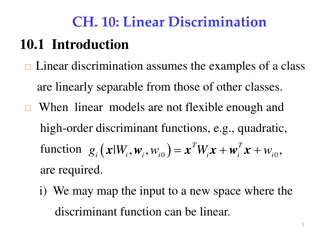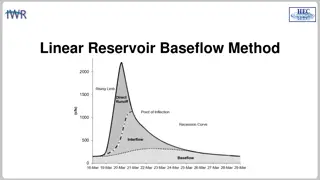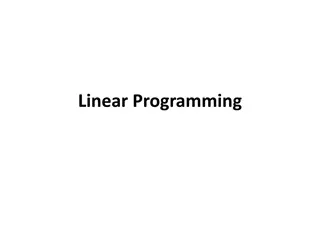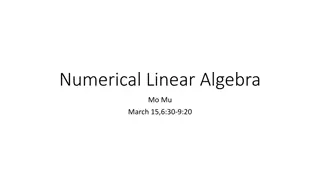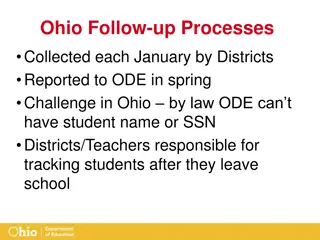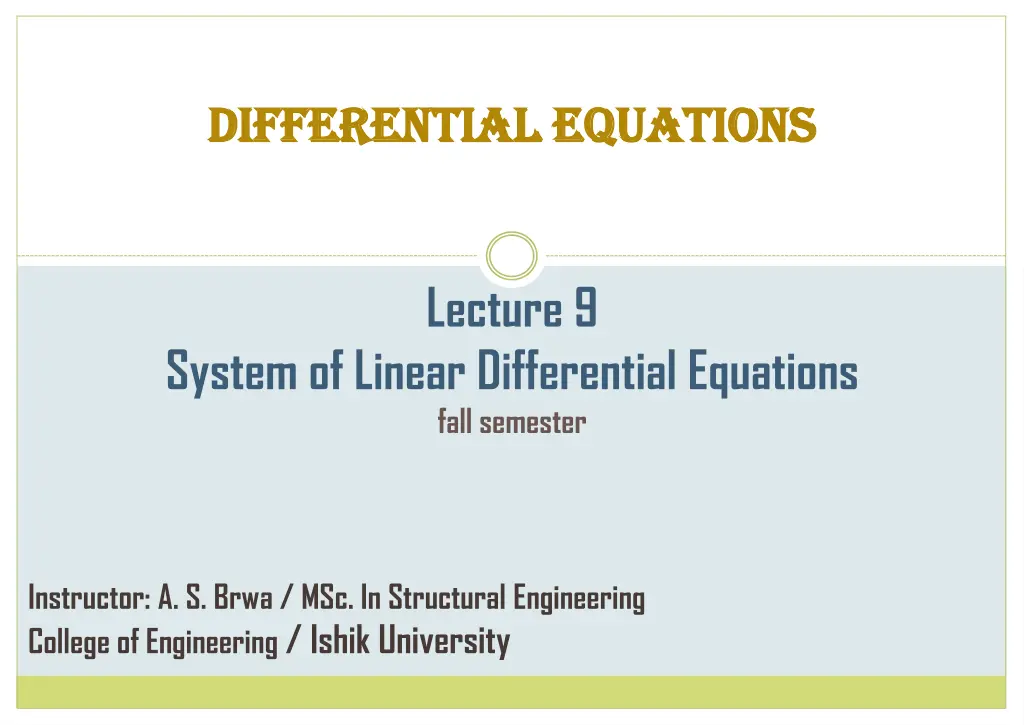
Linear Differential Equations Lecture at Ishik University
Explore the system of linear differential equations in the fall semester lecture by Instructor A.S. Brwa at Ishik University. Learn about solving systems of linear equations using matrix equations, understanding nonsingular cases, and determining unique solutions. Dive into examples to differentiate between conditional, identity, and contradiction linear equations.
Download Presentation

Please find below an Image/Link to download the presentation.
The content on the website is provided AS IS for your information and personal use only. It may not be sold, licensed, or shared on other websites without obtaining consent from the author. If you encounter any issues during the download, it is possible that the publisher has removed the file from their server.
You are allowed to download the files provided on this website for personal or commercial use, subject to the condition that they are used lawfully. All files are the property of their respective owners.
The content on the website is provided AS IS for your information and personal use only. It may not be sold, licensed, or shared on other websites without obtaining consent from the author.
E N D
Presentation Transcript
Differential Equations Differential Equations Lecture 9 System of Linear Differential Equations fall semester Instructor: A. S. Brwa / MSc. In Structural Engineering College of Engineering / Ishik University
Ishik University Linear System A system of n linear equations in n variables can be expressed as a matrix equation Ax= b: 2 Faculty of Engineering Differential Equations Lecture 9 System of Linear Differential Equations
Ishik University Linear System Nonsingular Case If the coefficient matrix A is nonsingular, then it is invertible and we can solve Ax = b as follows; ?? = ? ? ??? = ? ? ? ?? = ? ? ? ? = ? ? ? 3 Faculty of Engineering Differential Equations Lecture 9 System of Linear Differential Equations
Ishik University Linear System Nonsingular Case This solution is therefore unique. Also, if b= 0, it follows that the unique solution to ?? = ? ? ??? = ? ? ? ?? = ? ? ? ? = ? Thus, if A is nonsingular, then the only solution to ?? = ? is the trivial solution ? = ? . 4 Faculty of Engineering Differential Equations Lecture 9 System of Linear Differential Equations
Ishik University Linear System A system of linear (algebraic) equations, Ax = b, could have zero, exactly one, or infinitely many solutions. Type of Linear Equation Number of Solutions Indication when Solving Conditional One Final line is x = a number. Infinite; solution set {all real numbers} Identity Final line is true, such as 0 = 0. Final line is false, such as 0 = 20 . None; solution set Contradiction 5 Faculty of Engineering Differential Equations Lecture 9 System of Linear Differential Equations
Ishik University Linear System Example: Solve linear equation, Decide whether it is conditional, identity, or contradiction. 5x 9 = 4 x 3 5? 9 = 4? 12 5? 4? 9 + 12 = 0 ? = 3 So, this equation is Conditional And solution set = {-3} 6 Faculty of Engineering Differential Equations Lecture 9 System of Linear Differential Equations
Ishik University Linear System Example: Solve linear equation, Decide whether it is conditional, identity, or contradiction. ?? ?? = ? ? ? ?? ?? = ?? ?? ?? ?? ?? + ?? = ? ? = ? So, this equation is Identity And solution set = {real numbers} 7 Faculty of Engineering Differential Equations Lecture 9 System of Linear Differential Equations
Ishik University Linear System Example: Solve linear equation, Decide whether it is conditional, identity, or contradiction. ?? ?? = ? ? ? ?? ?? = ?? ?? ?? ?? ?? + ?? = ? ? = ? So, this equation is Contradiction And solution set = {} or no solution 8 Faculty of Engineering Differential Equations Lecture 9 System of Linear Differential Equations
Ishik University Linear System Ax = b If the vector b on the right-hand side is the zero vector, then the system is called homogeneous. A homogeneous linear system always has a solution, namely the all-zero solution (that is, the origin). This solution is called the trivial solution of the system. Therefore, a homogeneous linear system Ax = 0 could have either exactly one solution, or infinitely many solutions. 9 Faculty of Engineering Differential Equations Lecture 9 System of Linear Differential Equations
Ishik University Linear System There is no other possibility, since it always has, at least, the trivial solution. If such a system has n equations and exactly the same number of unknowns, then the number of solution(s) the system has can be determined, without having to solve the system, by the determinant of its coefficient matrix: 10 Faculty of Engineering Differential Equations Lecture 9 System of Linear Differential Equations
Ishik University Linear System Theorem: If A is an n n matrix, then the homogeneous linear system Ax = 0 has exactly one solution (the trivial solution) if and only if A is invertible (that is, it has a nonzero determinant). It will have infinitely many solutions (the trivial solution, plus infinitely many nonzero solutions) if A is not invertible (equivalently, has zero determinant). 11 Faculty of Engineering Differential Equations Lecture 9 System of Linear Differential Equations
Ishik University Eigenvalues and Eigenvectors Eigenvalues and Eigenvectors Given a square matrix A, suppose there are a constant r and a nonzero vector x such that ?? = ?? then r is called an Eigenvalue of A, and x is an Eigenvector of A corresponding to r. Remember, the eigenvalues and eigenvectors are always exist for any given square matrix 12 Faculty of Engineering Differential Equations Lecture 9 System of Linear Differential Equations
Ishik University Eigenvalues and Eigenvectors Rewrite the previous equation, we get ?? ?? = ? The next step would be to factor out x. But doing so would give the expression ? ? ? = ? Notice that it requires us to subtract a number from an n n matrix. That s an undefined operation. Hence, we need to further refined it by rewriting the term ?? = ???, and then factoring out x, obtaining ? ?? ? = ? 13 Faculty of Engineering Differential Equations Lecture 9 System of Linear Differential Equations



